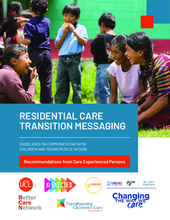For the purpose of these guidelines, the term ‘transition’ refers to the process of a residential care facility fully phasing out and permanently terminating the provision of residential care services. It does not refer to the movement of children and young people out of care in situations where the residential care facility is continuing to provide residential care as an ongoing service. In these guidelines, the term ‘transition’ can also be used interchangeably with the process of safe and planned closure of residential care facilities. For more details on the specific transition and closure settings for which the guidelines have been designed, refer to How to Use the Guidelines: Target Context.
Purpose of the Guidelines
The purpose of these guidelines is to support practitioners to develop messaging for children and young people that clearly communicates the intention to transition and the implications for children and young people in care. The guidelines seek to address challenges so that children and young people can fully understand the implications of transition and be granted opportunities to genuinely and appropriately participate in making decisions about their lives.
How to Use the Guidelines
Target Audience
The primary target audience for the guidelines are practitioners, whether in government or civil society organizations, who are implementing, overseeing, or providing technical support to residential care services undergoing transition or closure. This can include residential care directors with oversight over the transition of their own residential care service.
It bears noting that those responsible for developing transition messaging may not necessarily be the same people who implement a communications plan and communicate directly with the children and young people in care about transition. Ideally, the individuals delivering transition messaging would be skilled and experienced professionals who already have existing positive relationships with the children and young people in care. However, it is important to recognize that this is not always possible, and sometimes it is necessary to identify and bring in skilled practitioners for this purpose, as well as for the ensuing reintegration stage. Such an investment can be critical to the long-term stability of the children’s placements and the success of the overall transition process.
Target Context
While some of these guidelines may be applicable to a wide range of contexts, this resource has been primarily developed for voluntary transitions and closures with flexible timeframes. This includes self-initiated transitions and cases where RCFs are complying with government mandates or action plans to shift to family-based care.
The underlying assumption in these scenarios is that:
- the transition process will be primarily driven by the best interests of children;
- the budget is not severely restricted; and
- there is no immediate or acute risk of harm posed to children and young people by taking the time to adequately develop and deliver a comprehensive communications plan.
Conversely, these guidelines would not be suited for most rapid or emergency closure contexts, where moving children and young people out of a harmful situation is of the utmost urgency. While messaging is equally critical in such contexts, the content and delivery would be starkly different to what is recommended in these guidelines.

